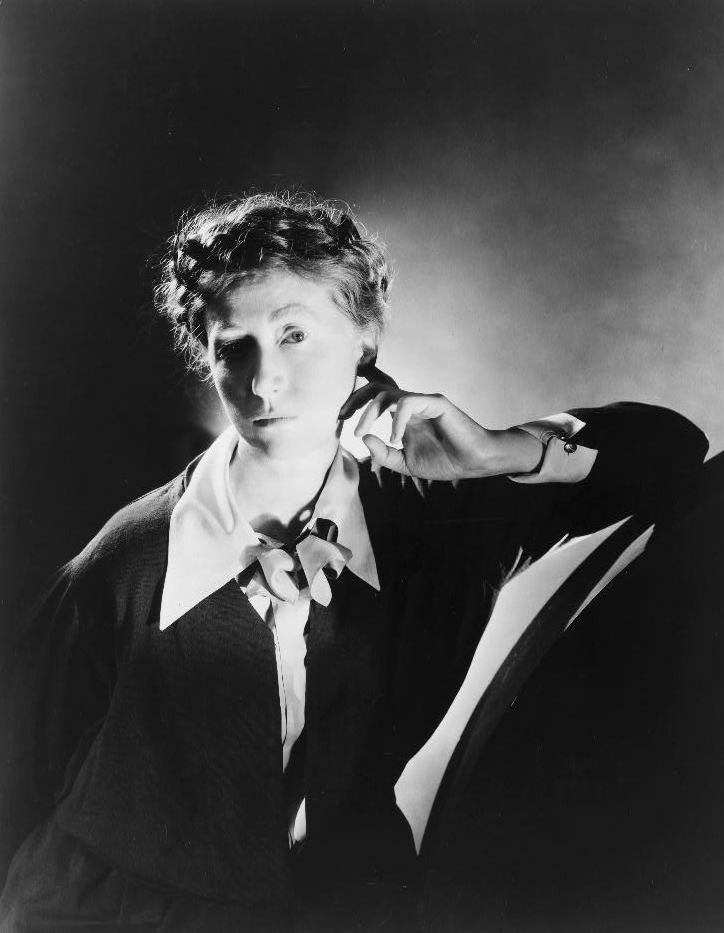61 Marianne Moore (1887 – 1972)
Amy Berke; Robert Bleil; and Jordan Cofer

Photographer George Platt Lynes
Source Wikimedia Commons
License Public Domain
If Robert Frost’s poems demonstrate a continuing fascination with decay, it may be said that Marianne Moore’s poetry reveals an equally compelling fascination with development. Like Dickinson and Whitman in the previous century, Moore was a compulsive editor and revisionist who apparently struggled over the publication of each of her poems. Like Dickinson, she wished to see her poems laid out exactly as she wished, but as a professional, rather than an amateur poet, she seized upon each opportunity for publication as a chance for revision. Thus, like with Whitman’s Leaves of Grass, it is difficult to call any of Moore’s poems finished. Each time they were printed anew, she revised them. In this way, Moore’s poetry works on a number of textual levels. Like Dickinson, Moore expressed hesitation at the appearance of her published work, but like her Modernist contemporaries, she embraced the opportunities that twentieth-century publishing, and the existence of numerous “little magazines,” offered.
Moore’s first published poems appeared in these “little magazines,” the literary and artistic journals of the early twentieth century, around 1915, and her work was widely praised by the literary gatekeepers of the day, including Ezra Pound and T. S. Eliot. But it was her first collection of twenty-four entries, Poems, published without her knowledge in July 1921, that made her name widely known in the literary world. By the time that Moore herself produced a collection of poems, 1924’s Observations, she was beginning to develop a reputation as a “poet’s poet” that was only strengthened by winning the Dial prize in 1925. After winning the prize in 1925, Moore became editor of the Dial, a post that she held for the next four years.
“Poetry,” the selection that follows, is a manifesto for Modernism, a demonstration of Moore’s command of both technique and artistry, and an instruction manual. As a manifesto, “Poetry” is both disdainful of the rigid forms that dominated most poetry what Moore calls, “this fiddle,” and celebratory of the experience of reading poetry. The experience of reading poetry, she argues, must yield an understanding of “imaginary gardens with real toads in them,” and not be merely sites for “high-sounding,” but “unintelligible,” attempts at communication. Thus poetry, Moore argues, must be both precise and genuine.
Moore demonstrates both precision and authenticity throughout the poem by using concrete, rather than traditionally poetic, language and by avoiding many of our expectations about poetry. Not only does Moore’s poetry fail to rhyme, but she also rejects Dickinson’s rigid hymnody, eschews Whitman’s free verse, and ignores Frost’s blank verse in favor of poetry that shares more of its syntax with prose and the spoken word than it does with traditional poetic forms. In place of lines and stanzas, Moore forces us to confront her poetry as a single unit where the expression begins with the first capital “I,” and concludes with a single period at the end of the last line. Entangled in this extended expression, Moore guides the reader to a new understanding of poetry that reminds readers of Whitman’s Song of Myself while it advocates not for a song in the traditional sense but for the importance of ordinary human speech. While reading “Poetry,” careful readers should take note of the differences between Moore’s monologue, in which no response is required from the reader, and the dramatic monologues of Frost whose speaker is always questioning.

